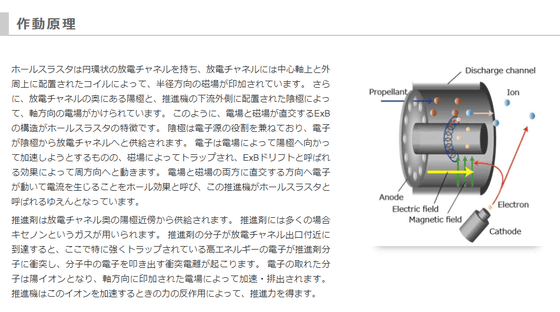The principle of the artificial satellite propulsion 'Hall thruster' is not really well understood.

by Charly W. Karl
Since the Space Race during the Cold War, humankind has sent many objects into outer space, such as artificial satellites and space shuttles. Lou ( @lougrims ), who studies plasma engines in Germany, explains that the principle of the ' Hall thruster ' used for rockets that send such objects is not really well understood.
So did you know that no-one really knows why the most used spacecraft propulsion system today actually works?
— Lou (@lougrims) April 18, 2022
I have been bored and kind of sick for the past 2 days so here is a quick thread on Hall thruster physics:
1 / pic.twitter.com/jCs22CV8yc
Hall thrusters are a type of electric propulsion machine that obtains thrust by ionizing propellants such as xenon and krypton and discharging the generated ions with a magnetic field. It was invented in 1970, which is not the latest technology in space development, but it is a long-lived technology that Starlink and others are still using.
In electric propulsions, injection speed and thrust are proportional to electric power, but most electric propulsors have the problem of limited electric power. However, Hall thrusters are still being used because the injection speed per power and the power are within the practical range.
Looking at the mechanism by which the Hall thruster operates, first, when electrons are emitted from the internal cathode and plunged into an annular part called the acceleration channel, the magnetic field causes the electrons to start rotating around the central axis in the acceleration channel. .. Lorentz force is generated by the Hall effect generated by the rotating electrons and the magnetic field, and the electrons are accelerated. Therefore, molecules such as xenone are sent to the accelerated electrons to collide with each other, causing impact ionization to eject the electrons, which is secondary. The flow is to discharge the generated cations and accelerate them.
Komitsu Koizumi Laboratory
http://www.al.tu-tokyo.ac.jp/hall_jp.html

This time, Mr. Lou explains that 'Hall thrusters cannot analyze the principle by calculation.' No matter what reasonable value is substituted for the electron temperature and ionization probability, the calculated 'number of electrons passing through the magnetic field' is only one tenth of the actual number.
So you take you pen and paper, put on some reasonable numbers on electron temperatures, cross sections, ionization probabilities, etc. And you end up with about 10 times less electrons making it through the magnetic field as it does in real life ...
— Lou (@lougrims) April 18, 2022
12 /
In recent years, computer simulations have been used for this type of analysis, but according to Lou, it is also difficult to use simulations. Since the gas density in the Hall thruster is very low, it is impossible to apply it to the Maxwell distribution that can analyze gas molecules as a whole. Therefore, it is necessary to perform simulation on the premise that 'each ion behaves as a separate particle' for Hall thruster analysis.
The same reasoning should be thought of as electrons behaving as separate particles, but electrons move much smaller in diameter and faster than ions, so there is not enough time for general researchers to perform simulations. Therefore, it seems to compromise on the premise that ions are particles and electrons are fluids.
Ideally you would also simulate the electrons as individual particles, but they are so much smaller and faster than the ions that it makes simulation time out of reach of normal researchers. So the compromise for most people is to use hybrid particle in cell codes.
— Lou (@lougrims) April 18, 2022
15 / pic.twitter.com/k22hAN7iwu
However, even if the simulation is executed on such a premise and the speed of the electrons in the Hall thruster is calculated, the result that comes out is much slower than the reality. Regarding the theory that explains the difference between this calculation and the reality, the theory advocated around 1980, 'When an electron collides with the ceramic used for the wall surface of the acceleration channel, an electron is generated secondarily' and ' It seems that there is a theory that plasma instability is occurring inside the thruster ', but since neither theory is a satisfactory explanation by itself, the hypothesis that these two theories are occurring at the same time is examined. It is said that it has been done.
However, this research does not require very expensive equipment, and the current Hall thrusters are not designed with an understanding of the principle, 'I repeated the experiment many times and succeeded. It was said that it was manufactured in the style of 'using things.'
So in conclusion we are still missing one of the fundamental reason why Hall thrusters work as they do. That makes it hard to derive scaling laws and theoretical design tools, which is why most Hall thruster design is very much an iterative and experimental thing.
— Lou (@lougrims) April 18, 2022
22/22 pic.twitter.com/SFmZOgHrWT
Related Posts:
in Science, Posted by darkhorse_log







